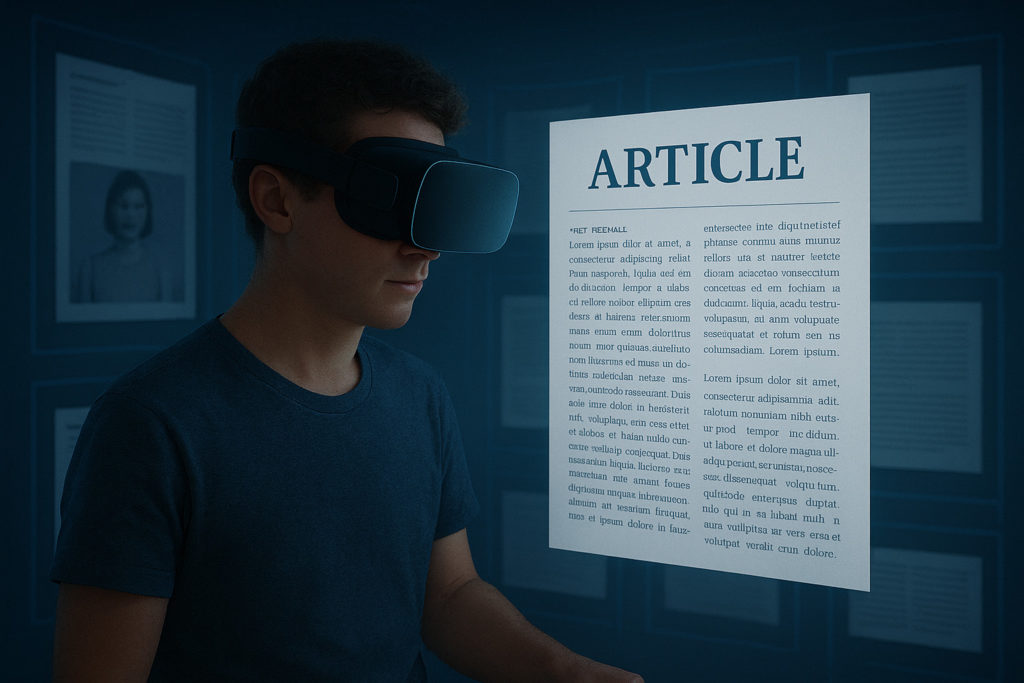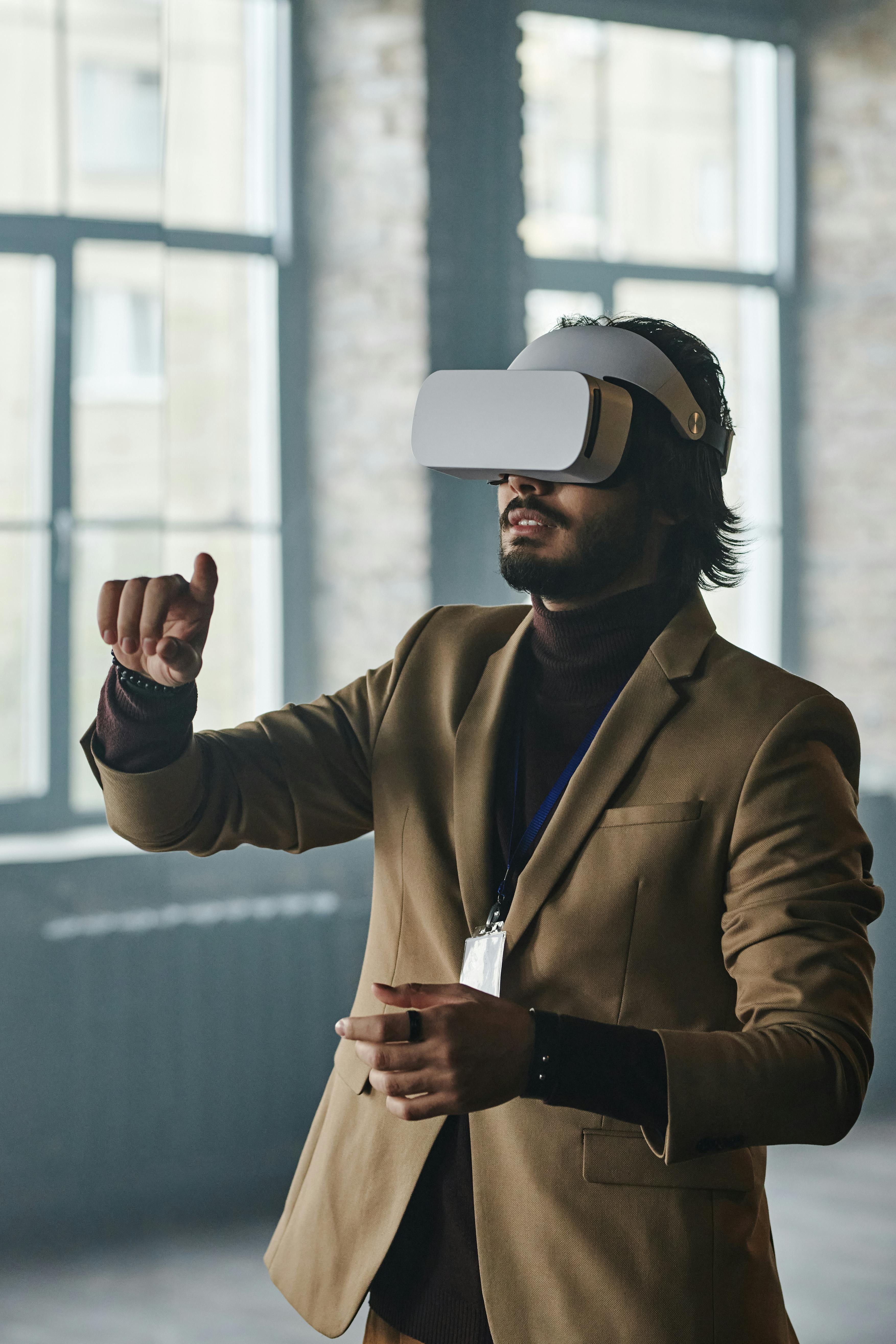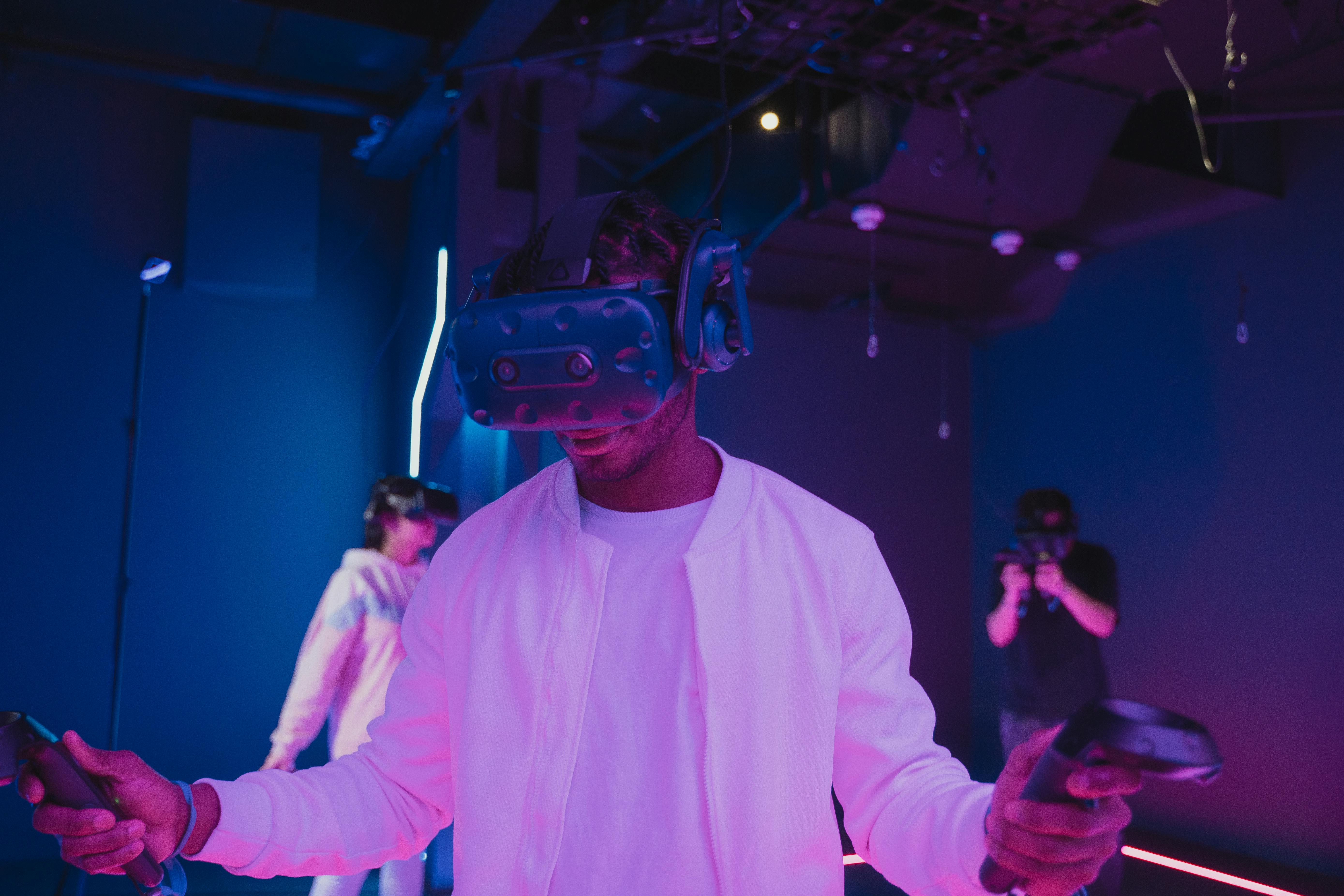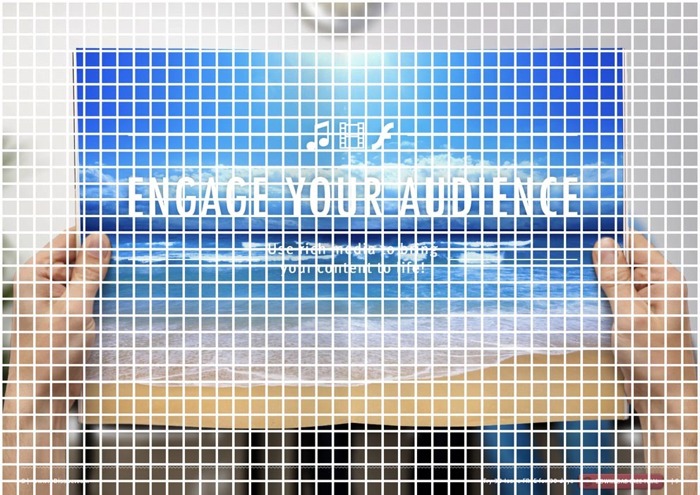
Remember Disclosure—that ‘90s thriller where Michael Douglas dons a clunky VR headset and strolls through a pixelated, wood-paneled filing system to uncover corporate secrets? Back then, virtual reality looked like a low-budget video game crossed with an IKEA catalogue.
Fast forward to today, and VR has traded in its wireframe cringe for crisp, high-resolution wonderlands. We’re no longer fumbling through digital cabinets—we’re walking through immersive magazine galleries, flipping pages in 3D space, zooming in on high-res content without a pixel in sight, and triggering 360° videos with a blink.
Let’s explore how the once laughable movie fantasy has matured into a cutting-edge reality for digital publishing—thanks to AR, VR, and some seriously clever tiling tech.

1. Enhance Visuals with Augmented Reality (AR)
Remember the feeling of flipping a page and having still images? Now, imagine those images springing to life. AR enables you to overlay interactive 3D models, videos, or animations on top of static content. Readers simply scan a page using their mobile device and unlock a new dimension—no heavy installations, just a QR code or a simple button.
- Bring Print to Life: If you’re publishing both print and digital versions, add AR triggers to the print version, making physical magazines interactive. For example, readers can scan a product photo and view a rotating 3D model or watch an embedded video review.
- Interactive Infographics: Complex data or infographics become much more engaging when viewed through AR overlays, allowing dynamic charts or pop-up info as the user explores different segments.
- How-to Guides & Tutorials: Let’s say your magazine features cookery or DIY—include AR steps where readers see the process unfold on their kitchen counter via their phone’s camera.

2. Immerse Readers in VR Storytelling
Nothing rivals the intensity of an immersive story. With VR, digital magazines can let readers step inside a scene—whether that’s a virtual art exhibition, a fashion runway, or a faraway travel destination.
- 360° Experiences: Embedding 360° panoramic images or videos in your digital pages lets users look around, sense the place, and linger—right from their tablet or VR headset.
- Virtual Interviews & Behind-the-Scenes: Instead of standard Q&As, invite readers into a virtual interview room or a backstage tour to connect with personalities.
- Supplementary VR Extras: As a publisher, you might offer exclusive virtual ‘extras’—a virtual gallery, concert, or interactive exhibition—for subscribers.

3. Add AR-Enabled Product Try-Ons and Demos
Brands in fashion, tech, or home decor are catching onto this trend—and so can magazine publishers who partner with advertisers. Offer AR try-ons or visualizations straight from your editorial or ads:
- Try Before You Buy: Let readers virtually place furniture in their room, try on glasses or watches, or even see makeup on their own face—all from a product feature they tap or scan.
- Interactive Shopping: Integrate AR-powered shop links, so the experience flows seamlessly from inspiration to action.
With platforms such as Flipbooks at 3D Issue, publishers can easily embed calls-to-action, video demos, or quick links, keeping the user engaged and making the entire journey from content to checkout delightful (and measurable).
4. Upgrade Ads & Sponsorship with AR/VR
AR and VR ad units are a win-win: more engaging for users and more valuable for your sponsors. Here’s how publishers are already using them:
- AR Coupons and Hidden Offers: Hide discount codes or special offers behind interactive elements—readers scan an ad and reveal a prize or animated coupon.
- VR Branded Environments: For long-form sponsored stories, create a mini virtual ‘pop-up’ experience—such as a branded lounge or interactive room—that integrates sponsor content but keeps the value high for your readers.
- 3D Configurators: Allow users to personalize a car, watch, or living space in 3D, and then share their creation, driving word-of-mouth organically.

5. Amplify Reach through Shareable AR/VR Social Moments
What’s the point of a breathtaking AR or VR moment if nobody shares it? Social integration lets engaged readers become your best promoters. Here’s how you can encourage it:
- Branded AR Filters: Create Instagram or Snapchat AR filters themed to a magazine issue—perfect for events, fashion, wellness, travel, or even quizzes.
- VR Milestone Shares: Add a ‘Celebrate’ or ‘Share Experience’ button at story milestones, allowing readers to post their journey or achievement directly to their network.
- Community Challenges: Feature a monthly AR or VR challenge, encouraging readers to compete, share, and vote on the most creative submissions.

Best Practices for Seamless AR/VR Integration
- Start Small, Build Impact: Don’t try to overhaul your entire magazine with immersive technology. Pilot one high-impact feature per issue (e.g., a VR travel story or an AR-powered advertorial) and measure the reader response.
- Prioritize Accessibility: AR and VR should be supplementary, not required. Make sure content is still accessible for all users and devices, using progressive enhancement.
- Measure and Iterate: Track interaction rates, social shares, click-throughs, or dwell time on immersive features separately to understand their contribution.
- Focus on Story First: AR and VR must serve the narrative, not distract from it. Every immersive enhancement should elevate the content’s core message or usability.
Implementation Tips (No Coding Headaches Required!)
Many modern content platforms now offer no-code or low-code integrations for AR and VR assets. For example, if you’re using responsive design platforms like Experios from 3D Issue, you’re already equipped to blend in rich media, including video, slideshows, and interactive hotspots.
- For AR, tools like image recognition triggers or QR codes are widely supported on mobile devices, allowing a smooth scan-and-see experience.
- For VR content, hosting on popular platforms like YouTube VR or Vimeo 360 ensures your assets stream smoothly on all modern devices.
- Use built-in SEO, analytics, and accessibility tools to optimize both the immersive and standard content for discovery and usability.
Future-Proofing Your Magazine’s Engagement
The most engaged readers are those who forget they’re simply scrolling—they’re immersed, participating, and connecting with your stories on every level. By thoughtfully layering in AR and VR, you reimagine what a ‘magazine’ can be.
The journey starts with curiosity and a single interactive moment. Whether it’s a responsive publication, an interactive flipbook, or a custom AR experience, publishers who experiment early and learn from their audience will be the innovators who lead the next era of digital storytelling.
How can 3D Issue help with this?

Experios is responsive so that content will automatically scale. If however you are using flipbooks, you are talking about scaling a fixed layout page. To render those pages in a highly visual environment like AR or VR then you need to use tiling techniques.
The desktop (Flipbooks) version of 3D Issue employs a tiling rendering system: each page is broken into high-res tiles at multiple zoom levels. To read more on that checklk out this article: Tiled Rendering for Digital Magazines
So how can tiling help:
Benefits:
- Reads crisply at any zoom without pixelation—key for detailed text or intricate imagery.
- Quick loading: tiles load on demand, so viewers enjoy smooth zooming and panning.
- Optimized performance on both mobile and desktop—minimizing lag while maximizing clarity.
For VR, where readers can virtually step inside the page, tiling ensures fine print, charts, and small visuals remain sharp during head-turns or focus shifts—enabling authentic, cinematic magazine exploration.
Merged Vision: AR + VR + Tiled Zoom = Supreme Experience
What a top-tier VR magazine looks like:
- Immersive gallery: Readers enter a virtual lounge with magazine pages suspended in mid-air.
- Interactive mag wall: Use VR controllers or gaze to scroll through larger tiled tiles—each page rendered in high resolution.
- Focused zoom pane: When a page is selected, an enlarged tile panel appears at eye-level—zoomable and crisp, highlighting text, infographics, and photos.
- Dynamic enrichments: AR-style overlays appear contextually—videos play, audio narrations pop and animated elements trigger within VR.
Why it works:
- Tiled zoom keeps text legible at close range.
- AR content adds layers of depth and immersion.
- VR environment delivers unparalleled focus and engagement.
Visual Strategy: Which Images to Keep & Where
To bring the article to life, strategically position visuals throughout:
| Section | Image Recommendation | Placement & Purpose |
|---|---|---|
| AR & VR Engagement | A mock-up of a tablet or phone overlaying a 3D model atop a spread | After the bulleted list—clarifies AR overlays |
| 360° Photo-Essays | Panoramic screenshot of a VR magazine with 360° environment | Adjacent to the 360° bullet—adds impact |
| Tiling Explanation | Diagram of a magazine page broken into high-res tiles | Next to the section explaining tiling—visual clarity |
| Virtual Gallery Concept | Concept art of a VR user immersed in a floating page gallery with zoom pane | Following merged vision—illustrates the ideal |
| Final Summary / CTA | High-energy VR environment, reflecting a finished immersive publication experience | At end—drives emotional call to action |
Next Steps & Call to Action
- Pilot AR/VR add-ons: Start with enriched hotspots or 360° experiences in a single issue.
- Enable tiling: Ensure desktop output uses tiled rendering with 100% quality for zoomed-in readability 3dissue.com3dissue.combrandxr.io3dissue.comthreekit.com.
- Prototype a VR gallery: Test with user feedback—how intuitive is navigation? Is the tiled zoom effortless?
- Analyze metrics: Measure time-on-page, zoom interactions, and social shares for each immersive element.
Conclusion
By blending AR overlays, immersive VR environments, and tile-based zoom rendering, you can deliver a digital magazine that’s not just read—but experienced. This future vision sets a new standard for publishing—deeply engaging, richly interactive, and technologically refined.
Ready to make your magazine stand out? Discover how Experios by 3D Issue empowers publishers to craft stunning, mobile-first, and interactive content that’s built for the future of publishing.







